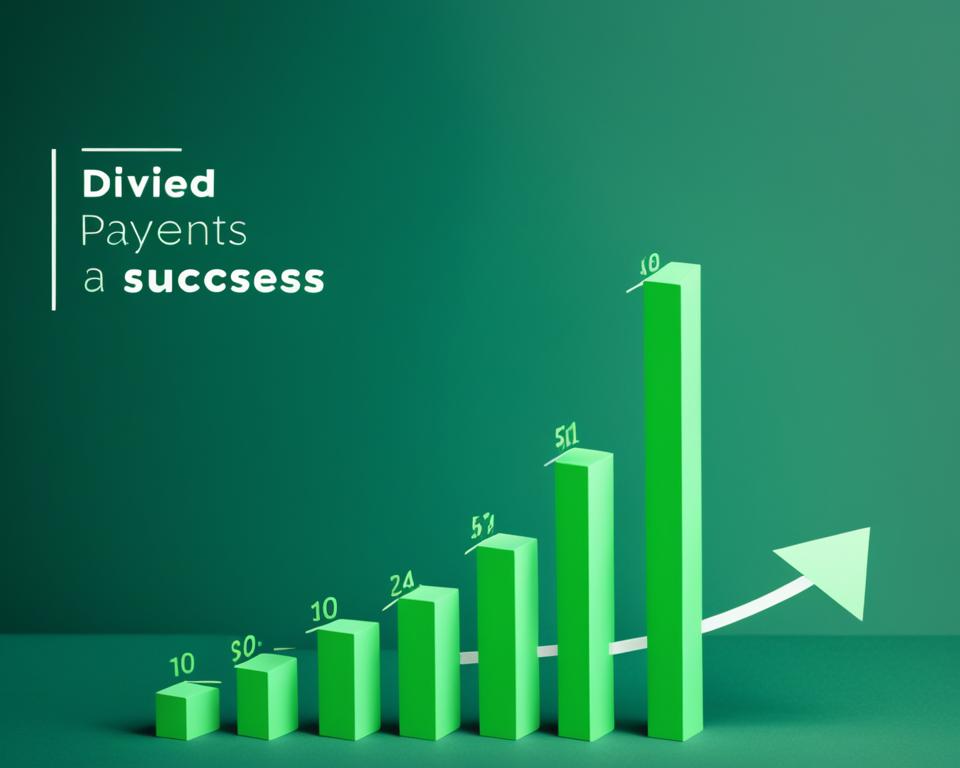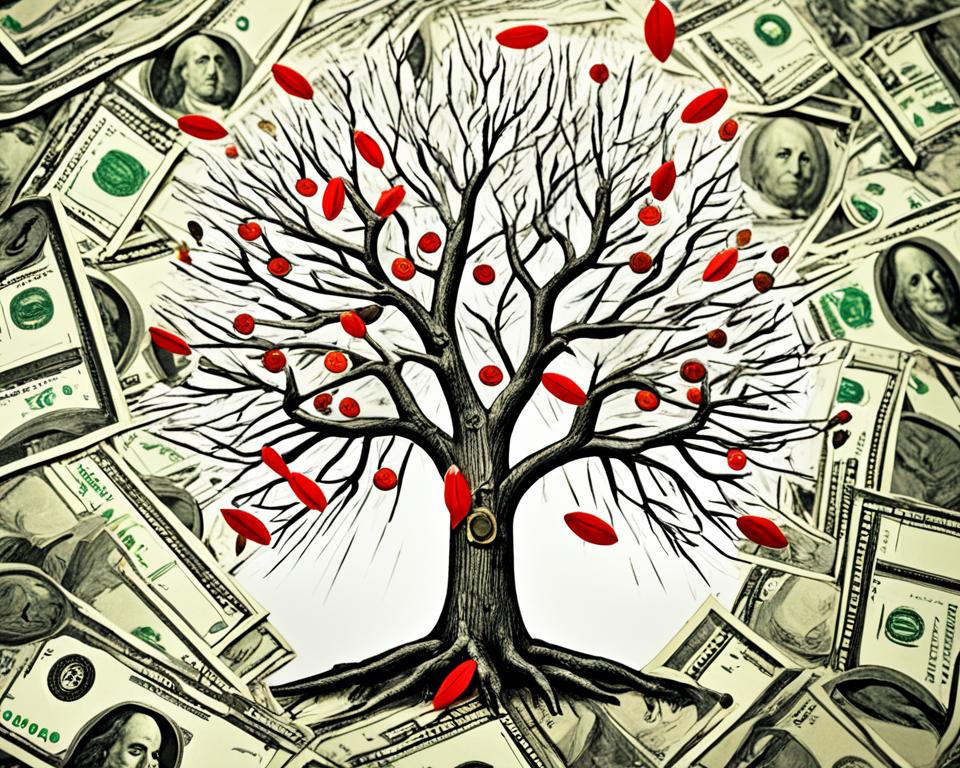Focusing on long-term wealth accumulation is like planting a tree. You nurture it, watch it grow, and eventually enjoy the fruits it bears. As you think about your retirement planning, consider dividends as the seeds that sprout into a stable financial future. Dividends—those regular payouts from companies to their shareholders—are more than just bonus cash; they represent a share of earnings, a reward for your investment, and a building block for your wealth.
Imagine an approach to financial growth that bestows you with a passive income stream, providing sustenance during your golden years. This is what dividend-paying stocks can offer. At the heart of savvy investment strategies, dividends add a layer of financial cushioning, launching you towards a secure retirement. Meticulously selecting stocks with a history of stable dividends can not only cushion you against inflation but also amplify your portfolio’s resilience during market downturns.
Key Takeaways
- Dividends play a significant role in building a passive income for retirement planning.
- Regular dividend payments can mean more predictable and stable returns, contributing to financial growth.
- Reinvesting dividends leverages the power of compounding, crucial for long-term wealth accumulation.
- Choosing companies with consistent dividend histories is a wise investment strategy for securing your future.
- The presence of dividends can indicate a company’s financial strength and its ability to prosper in varying economic conditions.
- Dividends provide a buffer against market volatility, reinforcing the sustainability of your retirement funds.
Demystifying Dividends in Wealth Building
Peering into the investment world, dividends have long held the spotlight as a key component of wealth accumulation strategies. These periodic payouts to shareholders can bolster your portfolio, not just through a passive income stream, but also by contributing to the overall growth of your investments. Uncover the roles that dividends play in your journey to financial prosperity, and see how they impact wealth accumulation.
As you map out your pathway to financial stability, it’s crucial to grasp the significance of dividend yield and its role as a barometer of investment value.
Understanding Dividend Yield and Its Importance
Imagine you’re assessing two securities; one pays a $1 dividend per year, with a stock price of $20, while another offers $2 on a $100 stock. At first glance, the second might seem more generous—but a closer inspection of their dividend yields, 5% and 2% respectively, tells a different story. Simple, yet potent, the dividend yield—calculated by dividing the annual dividend by the stock price—serves as your compass in navigating the investment landscape, ensuring your dollars are channeled into fruitful assets.
Measuring the Impact of Dividends on Total Returns
It’s not just the immediate income from dividends that sweetens the pot for investors. Dividends also serve as the silent heroes in the narrative of total returns. Let’s consider the venerable S&P 500 Index, a composite of prominent companies known for their reliable dividend disbursements. These dividends are not mere drops in a bucket; over time, they can cascade and swell into a significant stream, propelling the total returns of your investments—especially when you mobilize them back into purchasing more shares. This reinvestment maneuver unleashes the power of compounding, a cherished ally in your quest for wealth accumulation.
The Significance of Dividend-Paying Stocks for Investors
For investors aiming at financial growth, the allure of dividend-paying stocks often lies in their dual promise: potential for appreciation and a regular payout. This somewhat predictable income stream, known as passive income from dividends, acts as a buffer during economic uncertainties and can play an instrumental role in your strategic investment mix.
Imagine a quilt made of various financial securities, each patch representing a different type of investment. Among these, dividend-paying stocks stand out for their warmth and stability, much sought after in the chilling winds of market volatility. These stocks do more than offer comfort; they contribute to weaving a stronger financial safety net.
Generally, the bedrock of these valuable assets can be found in the robust S&P 500—a mix of 500 of the most widely held stocks known for their solid financial foundations and commitment to shareholder returns. The weight of dividends in such an index underscores their significance in evaluating company performance and investor returns.
The defensive characteristic of dividend-paying stocks is particularly beneficial. These stocks often have less price volatility, due to a steady demand from investors who appreciate the ongoing earnings through dividends. It’s this regular distribution of company profits that can fortify your portfolio against the tide of periodic economic downturns.
Critical to consider is the signal dividends send about a company’s confidence in its future cash flow. A consistent and possibly increasing dividend payout suggests a company’s belief in its ability to generate enduring profits. This factor alone can make dividend-paying stocks an attractive proposition for the conservative investor or for those prioritizing income, such as retirees.
Let’s lay out the benefits of incorporating dividend stocks into your portfolio:
- They can provide a steady source of passive income from dividends.
- They offer a lining of defense against market fluctuations and economic swings.
- They often indicate a company’s health and growth trajectory.
In your pursuit of financial growth and a diversified investment framework, you cannot overlook these stewards of stability. Dividend-paying stocks are not just an asset; they’re a wise approach to planting seeds of prosperity that could bloom into a lush canopy of wealth over time.
Dividends as a Source of Passive Income
As you build your portfolio with an eye toward securing your financial future, dividends emerge as a cornerstone for generating passive income from dividends. This form of income is a key player in meeting your long-term financial goals, serving as a steadfast ally on your journey toward retirement. Let’s explore how these regular payouts feed into the creation of your financial safety net.
Cash Dividends Versus Stock Dividends
On one side, we have cash dividends—the more traditional form—providing immediate, spendable income directly into your pocket or brokerage account. Their tangible nature offers immediate gratification and flexibility. On the flip side, stock dividends offer a different kind of charm by giving you additional shares, thereby increasing your ownership stake in the company without an immediate cash outlay. While cash dividends supply the fuel for immediate financial needs or reinvestment strategies, stock dividends plant seeds for your portfolio’s potential future growth.

As an investor, you’d want to know which type suits your financial strategy best. Suppose you’re leaning towards liquidity or need a reliable income stream—you might sway towards cash dividends. In contrast, if you are looking to expand your holdings without immediate tax implications, stock dividends could pique your interest. Both forms of dividends contribute uniquely to building a robust portfolio that aligns with your financial aspirations.
The Power of Dividend Reinvestment in Compounding Wealth
But the true magic happens when you harness the power of dividend reinvestment. This strategy can be a game-changer, escalating the compounding effect that significantly amplifies your wealth over time. Imagine every dividend payment as a new soldier in your army of assets, fighting to secure your financial freedom.
Here’s how it works: with every dividend received, rather than spending it, you reinvest—automatically buying more shares of the dividend-paying entity. With more shares comes more dividends; it’s a virtuous cycle of wealth expansion.
Consider the dividend aristocrats: companies with a distinguished record of consistently increasing dividend payouts each year. By reinvesting dividends from such stalwarts, you’re not just parking your money into a reliable avenue but actively greasing the wheels of a wealth-compounding machine. Over time, this strategy lays the foundation for a formidable nest egg, which is key for anyone eyeing a comfortable retirement.
Whether you’re eyeing retirement on the horizon or just beginning to sow the seeds for your financial future, dividends stand as a testament to the power of passive income. By strategically employing cash and stock dividends, and harnessing the compelling force of reinvestment, your financial goals might not just be within reach—they might arrive sooner than you’ve ever imagined.
Assessing the Stability of Dividend Income in Retirement Planning
As part of your retirement planning, you understand the importance of securing a stable income from dividends. This consistent cash flow lays the groundwork for a retirement free from financial worry, cushioning you against the unpredictable nature of the stock market. For those with their sights set on retiring, the allure of dividend income isn’t merely the potential for payouts—it’s the promise of predictability and financial resilience over time.
Consider the role of dividends as a steady financial stream. Companies renowned for their regular, and often increasing, dividend payments showcase a dedication to financial health, indicative of their long-term viability. As a retiree, every dividend declaration acts as an affirmation of your well-founded decision to focus on income stability over high-risk growth prospects.
When dividends are mentioned in the context of retirement, images of dividend aristocrats come to mind—those preeminent entities that have raised dividends year after year. They are the corporate embodiment of reliability, and steering your investment compass towards them can mean the difference between a retirement fraught with market anxiety and one of serene financial independence.
Let’s delve deeper into the essence of a stable dividend income:
- It’s a defense mechanism against market volatility.
- It counterbalances inflation, often growing in step with or beyond inflation rates.
- It speaks volumes of a company’s well-being, raising a flag of longevity in income generation.
- It serves as an income without eating away at the underlying investment, vital for the retired.
When evaluating which securities to populate your retirement portfolio with, those that offer a stable income from dividends should be at the pinnacle of your list. Corporate and government bonds alongside dividend-paying stocks not only promise income continuity but also work to preserve your capital. This dual nature of income and preservation is a beacon of light for retirees navigating the dim waters of post-working life.
The strategy is simple yet profound: balance your need for stable income with your desire to protect your principal investment. By doing so, you’re not just living off your savings—you’re allowing your portfolio to contribute positively to your livelihood.
And remember, the journey to a well-funded retirement is much like constructing a building; you must establish a solid foundation, then reinforce it layer by layer. In your financial edifice, dividends are both the cornerstone and the scaffolding that support and sustain your retirement years.
Ultimately, you desire a retirement where the phrase ‘fixed income’ doesn’t conjure up constraints, but rather, possibilities. Thus, pledge your allegiance to the power of dividends, for in them lies the blueprint to a secure, stable future as you embark on your golden years.
What role do dividends play in long-term wealth accumulation
As you journey through the investment landscape, the enduring presence of dividends comes into view, manifesting as a catalyst for long-term wealth accumulation. Let’s delve into the saga of dividends and their perennial role in fortifying investor portfolios, particularly within the vibrant tapestry of the S&P 500 Index. These regular returns not only serve as a beacon of consistency but also bolster the edifice of financial growth.
Historical Performance of Dividend Stocks in the S&P 500 Index
If we were to unfurl the chronicles of the S&P 500 Index, an impressive narrative of dividend stocks awaits us. It’s these stocks that have meticulously crafted a history of distributing earnings and facilitating steadfast financial growth through diverse market seasons. This index, a barometer of the market, teems with established companies whose dividends have often served as a constant in a sea of variables, underscoring their supreme importance in crafting a portfolio with a vision for wealth that endures.
Comparing Dividend Stocks with Growth Stocks
When placed side by side, the characteristics of dividend stocks versus growth stocks emerge in sharp relief. Dividend stock enthusiasts relish the predictability and tranquility of regular income, often coupled with a more tempered volatility—a sanctuary for those seeking a smoother ride towards long-term wealth accumulation. Conversely, growth stocks lure investors with the siren song of steeper price ascents, albeit at the surrender of dividend bounty. Striking the right chord between the two genres of stocks might just compose the most harmonious portfolio symphony, with crescendos of gains and interludes of income.
Corporate Earnings and Dividend Payments: The Connection
When considering your investment options, it’s important to understand how corporate earnings are a foundational element for dividend distributions. The financial prosperity of a company, as reflected in its earnings reports, often dictates its capacity to pay dividends to shareholders, forming a crucial part of their return on investment. This relationship between a company’s performance and your potential dividend income can be both illuminating and significant in shaping your investment decisions.

Dividend Payout Ratios and What They Tell Investors
One of the key indicators of how a company manages its profits in relation to dividends is the dividend payout ratio. This metric tells you, the investor, how much of the corporate earnings are being returned to shareholders versus how much is being retained for reinvestment. A delicate balance must be struck by the company to maintain healthy growth while also rewarding its investors. Consider this ratio as a snapshot of a company’s dividend-giving personality—does it prioritize reinvesting in future growth, or is it focused on providing immediate returns to its stockholders?
A table charting the dividend payout ratios of various sectors can provide invaluable insights:
| Industry Sector | Average Dividend Payout Ratio | Remarks |
|---|---|---|
| Technology | 30% | Typically lower due to reinvestment in innovation |
| Utilities | 70% | Higher ratio reflecting stable earnings and lower growth prospects |
| Health Care | 40% | Steady growth with balanced dividend policies |
| Consumer Discretionary | 35% | Varies with economic cycles, caution advised |
| Energy | 60% | Often higher due to consistent demand and cash flow |
How Companies Determine Dividend Distributions
The process by which companies decide on dividend distributions is a multifaceted one. As a shareholder, your dividends are a portion of the company’s profits, but not all profits are equal. Companies must weigh current profitability, future cash flow projections, as well as strategic investments, such as acquisitions or research and development. The board of directors then uses this information to determine how much of corporate earnings will be shared with you as dividends.
In times of robust earnings, companies may opt to increase dividend payments, signaling financial health and optimism about the future. Conversely, if a company faces headwinds, it may retain more earnings to safeguard its fiscal status, sometimes resulting in stagnant or even declining dividend payments. Ultimately, each company crafts its dividend policy with a blend of fiscal prudence and the desire to attract and reward you as a long-term shareholder.
Inflation and Dividend-Paying Securities
As you refine your investment portfolio, it’s crucial to consider strategies that offer inflation protection. Dividend-paying securities emerge as a compelling option, potentially defending your portfolio against economic turbulence. Their role in preserving purchasing power and providing solace during market swings cannot be overstated.
Protecting Purchasing Power through Dividends
In the quest to shield your income from the erosive effects of inflation, dividends stand out as a guardian. Companies keen on maintaining investor appeal often adjust their dividends in line with inflation, thereby safeguarding your investments’ real value. For instance, a report from Fidelity noted that, during inflationary periods, stocks with escalating dividends tend to outshine the broader market.
When your dividends grow consistently, they act somewhat like an inflation-adjusted annuity that helps in maintaining your lifestyle despite the rise in prices.
Dividends During Economic Downturns
Downturns and recessions test the mettle of investments. Yet, even amid such conditions, some companies continue rewarding shareholders with dividends. The resilience of these entities, often backed by robust balance sheets and a storied dividend history, provides you with impactful dividends during downturns.
During volatile periods, holding stocks that consistently dispense dividends could mean steadier returns, enabling you to uphold your spending power. It becomes even more important to vigilantly assess the financial health and dividend track records of these companies, keeping in mind that dividends, while indicative of a company’s stability, are not infallible guarantees.
Dividend Aristocrats: The Champions of Consistency
Within the realm of dividend investing, Dividend Aristocrats have carved out a reputation as the standard-bearers of consistent dividend growth. These esteemed companies have not just promised but delivered increased dividends annually for a minimum of 25 consecutive years. For you, the investor, they represent more than mere tickers on a screen; they symbolize reliability, demonstrating a steadfast approach to generating shareholder value through thick and thin.
Identifying Long-Term Performers in the Dividend Space
To anchor your portfolio with these bastions of stability, a dive into historical dividend records and financial fortitude is mandatory. Dividend Aristocrats cover a spectrum of industries, yet all share common threads — a history of weathering economic ebbs and flows while maintaining a trajectory of dividend increases. Their presence in your investment strategy can be the cornerstone for not just current returns but for a legacy of long-term financial growth.
Examining the Qualities of Dividend Aristocrat Companies
What sets Dividend Aristocrats apart? Robust revenue flows, judicious management decisions, and financial frameworks designed to support and sustain consistent dividend growth. In assessing these qualities, you’re not only identifying strong performers; you’re investing in companies with proven resilience. Such investments can serve as a bulwark, potentially dampening your portfolio’s volatility and furnishing it with a predictable income stream — essential criteria for those at the cusp of retirement or crafting a legacy of wealth.
Spotlighting these powerhouses of consistency within your portfolio could navigate you through the tumult of market swings and onto the shores of financial security. The illustrious list of Dividend Aristocrats currently includes well-known entities like Johnson & Johnson, Procter & Gamble, and 3M — titans of industry that have not only declared but also delivered on their promise of increasing dividends annually, making them the embodiment of long-term financial performers.
By intentionally including Dividend Aristocrats in your diverse financial portfolio, you leverage their historic and ongoing commitment to consistent growth. Such a strategy may not just solidify your investment foundation but can also play a significant role in shaping a prosperous financial future.
Retirement Portfolios and Dividends: Crafting Stability
As you approach retirement, the quest for a stable retirement income becomes increasingly paramount. You may find solace in the financial serenity that dividends for retirement offer, presenting not just periodic income but a semblance of the regular paychecks you’ve grown accustomed to throughout your career. Dividend-paying investments stand as pillars of resilience, capable of providing that desired constancy in cash flow.
What sets a retirement-friendly portfolio apart is its capacity to deliver income without necessitating the frequent sale of assets, thus safeguarding the longevity of your investments. By focusing on firms with a venerable track record of dividend payments, especially esteemed entities like the Dividend Aristocrats, you’re essentially weaving a tapestry of financial security.
- Dividends as regular streams replicating pre-retirement paychecks
- Preservation of principal by reducing the need to liquidate investments
- Enhanced income stability through a focus on proven dividend-payers
Consider the balance that a mix of bonds and dividend-growth stocks introduces. Such a strategy not only paves the way for income generation but also ensures capital preservation. To further this approach, let’s take a closer look at the types of assets you might incorporate into your retirement portfolio:
| Asset Type | Income Potential | Capital Preservation | Role in Retirement Planning |
|---|---|---|---|
| Dividend-Growth Stocks | High | Moderate | Grow the nest egg while introducing income |
| Bonds | Stable | High | Ongoing income and safeguard for invested capital |
| Dividend Aristocrats | Stable with growth potential | Moderate to High | Consistent dividend increases and defensiveness in market dips |
Furthermore, the assets in your retirement portfolio can be enshrined within tax-advantaged accounts, such as IRAs or 401(k)s, optimizing the efficiency of your tax planning. This methodical positioning magnifies your stable retirement income, bolstering your financial autonomy throughout the retirement years.

Ultimately, your mission in constructing a retirement portfolio enriched with dividends is not just about crafting an income stream. It’s about instilling peace of mind, knowing that your financial foundation is built on stable, dependable assets. It’s about ensuring that your golden years are as golden as you’ve dreamt them to be.
Tax Implications of Dividend Investing
When embarking on the path of dividend investing, it’s essential to navigate the tax implications to ensure you are maximizing after-tax returns. Understanding how dividends are taxed can greatly impact your investment outcomes. Certain types of dividends, known as qualified dividends, could qualify for lower tax rates, while others are taxed as ordinary income.
Understanding Qualified Versus Ordinary Dividends
Qualified dividends are typically given preferential treatment because they are taxed at the capital gains tax rate which is generally lower than the ordinary income tax rate. To benefit from these lower rates, personal investors must hold the stocks for a specified minimum period—more than 60 days within a 121-day period beginning 60 days before the ex-dividend date. Ordinary dividends, in contrast, are subject to federal income tax at the investor’s regular tax rate, which might be higher depending on their income bracket.
Strategies to Optimize After-Tax Returns from Dividends
Investors looking to make the most of their dividend investments should strategize to lower the tax on dividends. Using tax-advantaged accounts, like Individual Retirement Accounts (IRAs) or 401(k)s, to hold dividend-paying securities is a smart move. This can shelter your investments from immediate tax burdens, offering the potential for dividends to grow tax-deferred until retirement. Furthermore, enrolling in Dividend Reinvestment Plans (DRIPs) can streamline the process of reinvesting dividends, which can delay personal tax obligations and compound your investment’s growth.
Staying updated with changes in tax laws and actively working with financial professionals can help ensure your investment strategy remains efficient and productive. Keeping an eye on dividend payout ratios and yields can also guide you in selecting stocks that complement your financial aspirations and tax planning goals. Here are some tips to get the most out of your dividend investments:
- Monitor the duration you hold your dividend-paying stocks to ensure they qualify for preferable tax treatment.
- Consider the timing of dividend payouts within your broader investment strategy to align with potential tax changes.
- Think about the balance between high-yield dividend stocks and growth stocks based on your individual tax circumstances and future rate expectations.
- Engage with financial advisors to adapt your portfolio to evolving tax regulations wisely and proactively.
By deftly managing the tax aspects of your dividend investments, you can enhance your wealth-building endeavors, ensuring a sturdier financial portfolio against the ebbs and flows of the market.
Identifying High-Quality Dividend Stocks
When you’re choosing dividend stocks, the quest for quality can’t be overstated. It’s akin to selecting the finest ingredients for a gourmet recipe. You want to ensure that the companies you invest in have a robust financial foundation, marked by consistent earnings and a track record of dividend reliability or growth. This search for quality dividend investments necessitates a careful look at corporate earnings, dividend payout ratios, and how management policies might affect dividend sustainability.
One hallmark of a quality dividend investment is its ability to weather the storms of economic downturns, demonstrating resilience by maintaining or even increasing dividends when other companies may falter. This is why seasoned investors often look for companies that not just survive but thrive during turbulent market conditions.
To streamline your selection process, let’s explore some essential factors that characterize high-quality dividend stocks:
- Financial Strength: Companies that have strong balance sheets and positive cash flows are better positioned to provide sustainable dividends.
- Payout Ratio: A lower payout ratio suggests that a company retains enough of its earnings for growth initiatives while also rewarding investors.
- Dividend History: A long and stable history of dividend payouts is indicative of management’s commitment to shareholders. Companies that have been able to maintain or increase their dividends over a significant period stand out as reliable choices.
- Growth Potential: Businesses that exhibit potential for future growth can offer the best of both worlds: the potential for capital appreciation alongside a steady dividend income.
To add clarity to this criteria, consider the following table comparing hypothetical companies based on these essential factors:
| Company | Financial Strength | Payout Ratio | Dividend History | Growth Potential |
|---|---|---|---|---|
| Company A | High | Low (25%) | Stable (20+ years) | Moderate |
| Company B | Moderate | Moderate (50%) | Variable (10+ years) | High |
| Company C | Low | High (80%) | Unstable (< 5 years) | Low |
Upon examining the above table, Company A demonstrates signs of a quality dividend investment due to its strong financial standing, room for growth, and a demonstrated history of stable dividends. This detailed assessment, coupled with an evaluation of the broader economic environment and potential regulatory changes, carves a pathway to making well-informed decisions.
Ultimately, the process of choosing dividend stocks requires both a science and an art. By combining methodical financial analysis with a strategic overview of market conditions, you can enhance your portfolio with dividends that not only provide immediate income but also promise growth, stability, and long-term wealth accumulation.
Conclusion: Dividends as an Integral Part of Financial Growth and Security
In the grand tapestry of investment strategies, it cannot be overstated how pivotal dividends are to achieving financial stability and growth. As you look back on the insightful journey through the world of dividends, you can appreciate their role as a powerful component in securing a robust financial future. They offer you a strategic advantage, granting you not just a stream of passive income but also the potential for capital gains and the potent force of compounding when reinvested. It’s this trifecta of benefits that can significantly elevate the strength and health of your investment portfolio.
Dividends are more than just an extra perk; they are a testament to a company’s solidity and a beacon of reliability in your wealth-building voyage. Whether you’re in the wealth accumulation phase or crafting a retirement strategy, incorporating dividend-yielding stocks is a sage move toward financial prosperity.
The Role of Dividends in Diversifying Investment Portfolios
The investment landscape underscores the critical importance of portfolio diversification, and dividends earn their keep in this realm. By including dividends in diversifying your portfolios, you diminish the overall risk, ensuring a more balanced and robust investment mix. Dividends serve as a cushion against the intermittent shocks of market volatility, offering you a semblance of control in an otherwise unpredictable market. This strategic inclusion bolsters not only the defense of your portfolio but also its capability to thrive in a variety of market conditions, fulfilling both immediate and long-term financial objectives.
Future Prospects for Dividend Investing in Evolving Markets
Glancing forward, the dividend investing outlook remains a topic of vivid discussion, adapting continuously to shifts in market dynamics. While technology and biotech sectors typically reinvest earnings back into their businesses for growth, other industries—like consumer goods, energy, and utilities—are historically more inclined toward rewarding investors with dividends. These sectors often house companies with longstanding traditions of dividend payouts, an attribute that you might find particularly attractive. Vigilant oversight of industry trends, economic signals, and corporate dividend policies will stand you in good stead as you navigate the future of dividend investing. By doing so, you craft not just a resilient and diversified portfolio but one that is primed for enduring success in the changing tides of the global economy.
FAQ
What role do dividends play in long-term wealth accumulation and retirement planning?
Dividends are essential for long-term wealth accumulation and retirement planning as they provide a source of passive income and the potential for capital growth when reinvested. They add stability to a portfolio by offering predictable returns, thus decreasing volatility and providing a buffer during market downturns. For retirees, dividends can serve as a regular income stream to fund living expenses without depleting their investment principal.
Why is understanding dividend yield important?
Understanding dividend yield is crucial as it gives you insight into the potential return on your investment relative to its price. It allows for a quick comparison between different dividend-paying stocks and can help you assess whether an investment fits within your yield expectations and investment goals.
How do dividends impact the total returns of an investment?
Dividends can have a significant impact on the total returns of an investment, particularly when they are reinvested. They contribute to both the income and growth components of an investment’s total returns. Over time, the compounding effect of reinvested dividends can substantially increase the value of your investment.
What makes dividend-paying stocks appealing to investors?
Dividend-paying stocks are appealing due to their dual benefit of income through regular dividend payments and potential capital appreciation. They often indicate corporate financial health and provide investors with a degree of financial stability and lower volatility compared to non-dividend-paying stocks.
What are the differences between cash dividends and stock dividends?
Cash dividends are direct cash payments made to shareholders, providing immediate income or liquidity. Stock dividends consist of additional shares of the company, contributing to equity growth and allowing shareholders to compound their investment without immediate tax consequences, though the value of each share may be diluted.
How does dividend reinvestment contribute to compounding wealth?
Dividend reinvestment amplifies the compounding effect on wealth by using dividend payouts to purchase more shares of the stock. This increases the number of shares that will generate dividends in the future, potentially leading to increased dividend income and a greater accumulation of shares over time.
Why is the stability of dividend income important in retirement planning?
Stability of dividend income is crucial in retirement planning as it provides predictable and regular cash flow for retirees, which can reduce the need to sell investment assets—a process that can erode the investment’s principal. Consistent and reliable dividends alleviate financial stress by covering living expenses and preserving long-term portfolio value.
What historic role have dividend stocks played in the S&P 500 Index?
Dividend stocks in the S&P 500 Index have historically played a critical role in wealth accumulation for investors. These stocks have consistently provided stable dividends through varying market conditions and have contributed significantly to the total returns of the index over time.
How should investors compare dividend stocks with growth stocks?
When comparing dividend stocks with growth stocks, investors should consider that dividend stocks typically offer lower capital growth potential but provide recurring income. Growth stocks may offer higher potential for capital appreciation but do not typically distribute dividends. A balanced portfolio may include a mix of both to hedge against market volatility and achieve financial growth.
What is the dividend payout ratio and why does it matter to investors?
The dividend payout ratio is the fraction of a company’s earnings paid out to shareholders as dividends. It matters because it provides insights into how much money the company is returning to shareholders versus reinvesting back into the business for future growth. It also can signal a company’s dividend sustainability and future dividend potential.
How do companies determine their dividend distributions?
Companies determine their dividend distributions based on profitability, cash flow expectations, and management’s strategic priorities. The board of directors weighs these factors along with the company’s financial health and shareholder expectations to set dividend policies that are sustainable and reflect the company’s long-term objectives.
How can dividend-paying securities protect purchasing power during inflation?
Dividend-paying securities can help protect purchasing power during inflation because many companies strive to increase their dividend payments in line with inflation rates. This allows investors to receive higher dividends that can help offset the reduced purchasing power caused by rising prices. Moreover, historically, dividend-growers have often outperformed during inflationary periods.
How do dividends perform during economic downturns?
During economic downturns, dividends from financially robust companies can provide a steady income stream, which helps to cushion the adverse effects of falling stock prices. Even though dividends can be reduced or suspended, established companies with solid balance sheets are more likely to maintain their dividends during such times, providing a reliable source of income for investors.
What makes Dividend Aristocrat companies special in the investment world?
Dividend Aristocrat companies have a proven track record of increasing their dividends annually for at least 25 consecutive years. This consistency showcases their financial strength, responsible management, and commitment to shareholder returns. These companies are especially attractive for long-term investors seeking stable income and less volatile investment options.
How can investors identify strong long-term performers for dividend investments?
Investors can identify strong long-term performers for dividend investments by analyzing historical dividend records, financial statements, cash flow robustness, and business models. Looking for companies with persistent dividend growth, even through economic downturns, can indicate their ability to provide stable, long-term returns.
What strategies should retirees consider when including dividends in their portfolios?
Retirees should consider strategies that emphasize stable, predictable dividends, such as investing in Dividend Aristocrats or companies with a strong dividend history. This helps create a reliable income stream. Balancing these stocks with bonds can also help manage risk while planning for tax efficiency, especially within retirement accounts, can optimize returns.
What tax considerations should be taken into account with dividend investing?
When it comes to dividend investing, investors should understand the difference between qualified dividends, which are taxed at lower rates, and ordinary dividends, taxed as regular income. Positioning dividend-paying assets in tax-advantaged accounts can also help minimize tax liabilities. Tax planning is essential to maximize the after-tax returns from dividend investments.
How can investors identify high-quality dividend stocks?
To identify high-quality dividend stocks, investors should look for companies with strong financial health, consistent earnings, a track record of stable or increasing dividends, and a reasonable payout ratio that suggests future growth and sustainability. Investing in firms that demonstrate adaptability during economic downturns can also be indicative of dividend quality.
What role do dividends play in diversifying investment portfolios?
Dividends play a critical role in diversifying investment portfolios as they can reduce overall risk and enhance stability. They provide regular income which can help to smooth out the returns from a portfolio, exhibiting less sensitivity to market fluctuations and thus offering a buffer during periods of uncertainty.
What are the prospects for dividend investing in evolving markets?
The prospects for dividend investing in evolving markets remain positive as dividends are a foundational aspect of shareholder returns. While certain sectors may not traditionally offer dividends, shifts in market trends and investor preferences could result in broader adoption of dividend policies in growth-focused industries as well as traditional ones.












